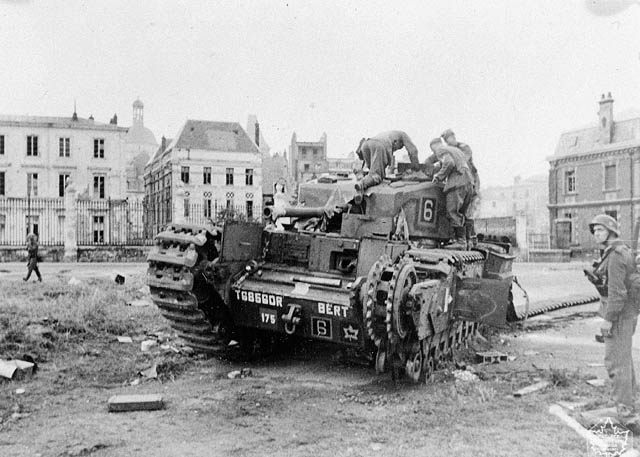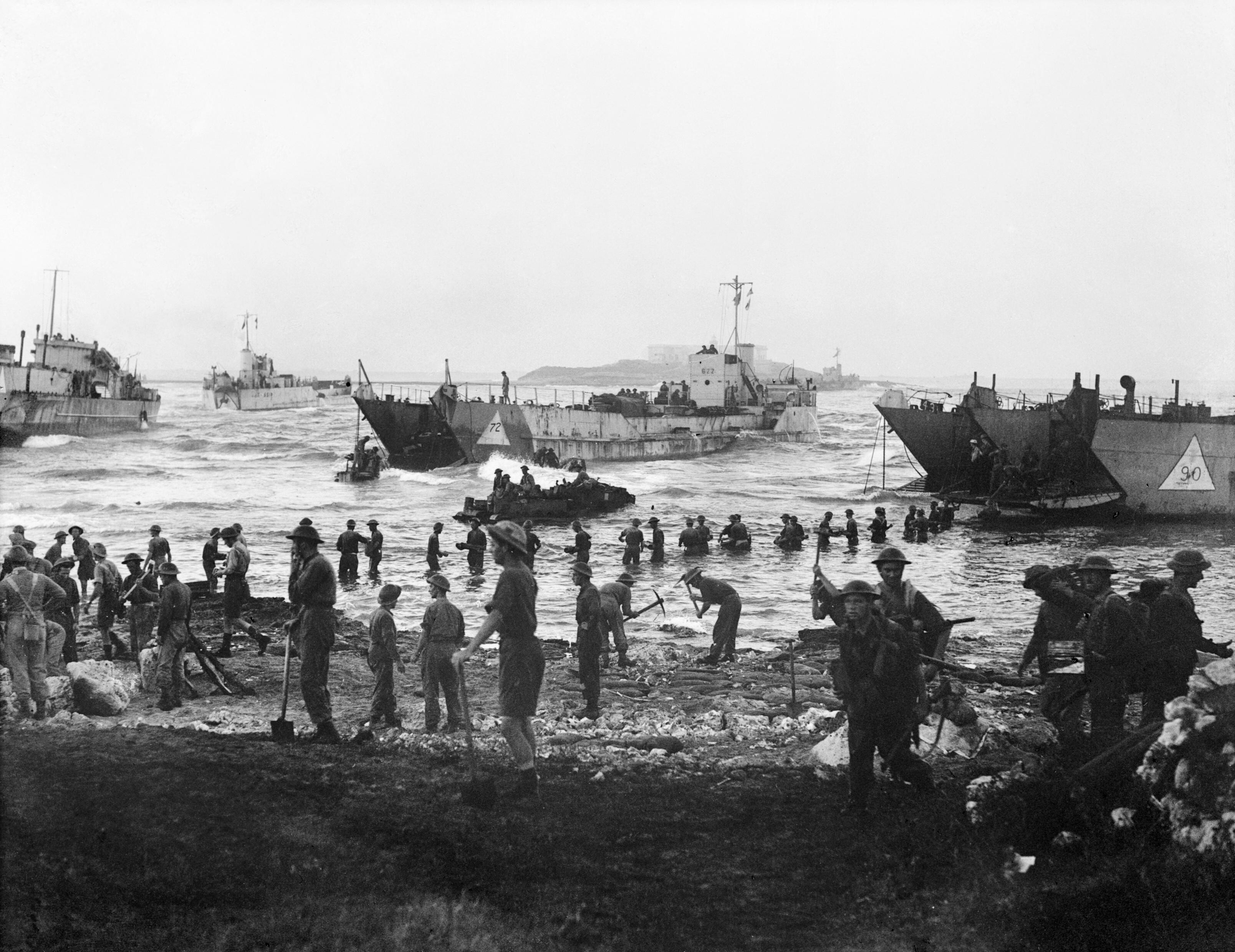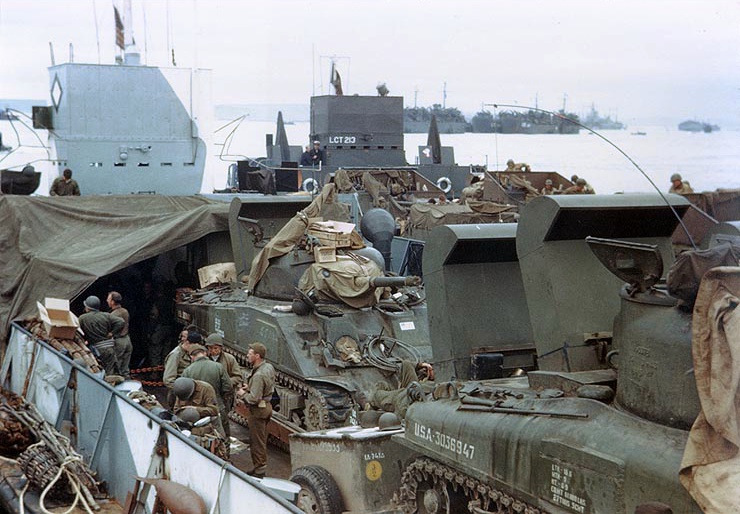Welcome back to the Armory. Last time in our Part-1 article, we built up the context about the history of amphibious landings, and how many limitations had been overcome with shipbuilding and navigation becoming far more sophisticated. This week we will specifically focus on WWII in the Atlantic and Mediterranean, where several major Allied landings took place. I should also mention our sci fi titles are currently on sale. Unfortunately planetary invasions lay outside the scope of amphibious landings, but the two often do rhyme when it comes to fiction.
I must also apologize to our Commonwealth friends if this article looks like it gives them short shrift. If we talked about the Americans and the British, this article would balloon to a ridiculous size. To our readers its important to remember that the Americans and British (along with other Allied and Commonwealth forces) are learning operational lessons and taking heavy losses together, along with collaborating on their invasion targets.
While differing political objectives did lead to different priorities, WWII serves as a good example of how two different countries can balance priorities and achieve mutual objectives. Without any hyperbole, multinational alliances conducting combined invasions and amphibious operations are probably one of the most complex and dangerous endeavors people can undertake.
I should also mention that much of the background for this piece comes from the Army at Dawn/Liberation series by Rick Atkinson. This series covers the United States Army’s involvement in the European theatre from 1942-1945, and is an excellent broad narrative history.
This is going to focus primarily on American landings for the sake of time, but it’s important to mention some key British contributions as well.
The first landings we will mention were not invasions, but raids. The British engaged in several raids and commando operations after the Fall of France. These served both as useful chances to gather intelligence and damage German military infrastructure, but also to diplomatically and psychology stay an active participant in the European theater. The Bruneval raid and the Raid on St. Nazaire are excellent examples of these kinds of limited operations.
Dieppe on the other hand, was a far larger raid that turned fiasco. Of the 6000-odd men landed, around 3600 were killed, wounded or taken prisoner. Troops had landed directly at a harbor beach, attempting to take the coastal town by storm. Barricades and urban fortifications made this nearly impossible, and the majority of the armor in the attack bogged down on the beach. Dieppe was a bloody lesson that ports could not reliably be taken directly by naval landings, and that tanks would require special adaptations to get ashore and off the beach.

A Churchill tank abandoned after the Dieppe raid.
The vehicles used in modern amphibious operations had evolved from ships boats to proper purpose built landing craft. The most famous of these for WWII are probably the Higgins boats (LVCP) and Amphtracks (LVT). Both were used by the Army and Marines. The Higgins boats were equipped with a front ramp and capable of carrying infantry, while the Amphtrack (more noticeable in the Pacific) had a rear exit ramp and could carry either infantry or a Jeep.
Heavier landing craft like the LCT (Landing Craft Tank) or LCI (Landing Craft Infantry) could be sent in, sometimes even in the first wave, to deploy far larger numbers of troops and equipment directly onto the beach. Their size however, made them far more visible targets to attack from the air or shore batteries. While the Allies had tremendous industrial capacity they never had enough landing craft to conduct all the amphibious operations they wanted. For example, after the landings at Anzio in January 1944, landing craft had to be re-allocated to Normandy, ending large scale amphibious landings in the Mediterranean.
The first large scale American naval landing in the Atlantic/Mediterranean theater was operation Torch. While Rangers had been present at Dieppe, the American army was largely new and untested. Pearl Harbor was December 7th, 1941, Torch was November 9th, 1942. A year is not a lot of time to mobilize millions of men and get them ready to fight the most destructive war in history.

A map of planned Torch landings. Algiers was the furthust eastern landing zone that could still be reliably protected from air attack.
Torch and the North African theater was almost ideal for an untested army like the one the United States possessed. Facing Vichy French forces, the ability for the Germans or Italians to reinforce North Africa was hampered by increasing Allied naval and air superiority in the theater, and the increasing strength of the Soviet Union on the Eastern Front. This is not to say that Torch or North Africa was a walk in the park, but the chances of an Allied landing being thrown back into the sea was far less than a direct thrust at Italy or occupied France. The British contributed both ground forces and air/naval support to Torch.

A message to the Arabs and French of north Africa explaining that the invaders were Americans, and not the British. The French felt resentment to the British after the Attack on Mers-el-Kebir.
Torch saw landings at Oran, Algiers, and Morocco. These landings were geographically split up both to secure key bases like harbors and airfields, and to give good staging grounds for further operations against Tunisia. The initial plan was for a rapid dash towards Tunisia to try and cut Rommel’s lines of supply. Like any amphibious landing there was confusion and disorganization, doubly so because the American army and officers were so fresh.

American troops in a landing craft. Torch was the first combat experience for most American troops in the Atlantic/Mediterannean theater.
Torch was a successful operation. While the attempt to take Tunisia was frustrated by German counterattacks at Djedeida. Casualties were relatively light and the American army gained useful experience. Even the later defeat at Kasserine was a learning experience, payed in blood as they often are in war.

American and British troops unload cargo and vehicles on-shore. Wide open beaches can be difficult to attack, but are crucial for the unloading of troops and supplies.
Torch was successful largely because of allied naval and air superiority. Escort carriers like the HMS Avenger (which was sunk during the operation) provided much needed air cover to both troops and convoys carrying supplies and reinforcements past Gibraltar. It was primarily due to German airbases in Tunisia and Sicily that landings didn't occur further east than Algiers. A troops ship, no matter how well escorted, is a very vulnerable target to air-power.

Infantry landing during Torch. Note the American flag leading the advance. It was hoped Vichy French forces wouldn't fire on Americans.
Once Tunisia was secured months later, the next big Allied amphibious operations were in Italy, primarily Operation Husky in Sicily in July 1943, and Operation Avalanche on mainland Italy in September. These operations incorporated many of the lessons learned from Torch. Many poor performing officers had been weeded out thanks to the earlier Torch and Tunisian campaigns.
Paratroopers were employed on a larger scale during Husky, at reinforced regimental strength under General James Gavin. A frequent problem that was not solved was the invasion flotilla firing on friendly aircraft. No matter how degraded the Luftwaffe had become, Allied ships had a terrible tendency to open fire on friendly transports carrying paratroopers. This friendly fire incident scattered the paratroopers and made their drops even more inaccurate than usual, frustrating the Allied attempts at vertical envelopment.

Paratroopers during operation Husky. This regimental sized drop would be surpassed by the use of three whole divisions during D-Day.
Husky saw far more combat casualties in the first days of the landings due to higher concentrations of Italian and German troops defending the island. The 16th Panzer Division launched counterattacks that attempted to drive into the Allied beachhead of Husky. The greatest existential threat for landing troops was enemy armor driving directly into the beachhead and forcing an evacuation, or potentially capturing thousands of troops and hundreds of tons of supplies. Naval gunfire helped break up the German counterattack however, and the allied beachheads eventually developed enough width and depth to begin exploiting inland. Sicily fell in a little over a month of continued operations.

Smoke and dust from the shore bombardment during operation Husky. Even if naval gunfire missed it's target, it was still terrifying and disruptive.
After Husky and Avalanche, the Italian theater bogged down into five months of attrition al mountain fighting around prominent terrain features like Monte Casino. Italy is a mountainous country, well suited to defense. To outflank these strong German positions, landings at Anzio were attempted to bring back maneuver to this theater. These landings occurred in January of 1944.

Commonwealth forces landing during Husky.
Anzio, like Husky, almost saw Panzers drive into the Allied beachhead (anecdotally, Pink Floyds “When the Tigers Broke Free” is about this counterattack, where Roger Waters father was killed). It was only in desperate, heavy fighting on their final prepared line, and with copious amounts of artillery, that the German counterattack was stopped. With both Husky and Anzio, the Germans came very close to breaking into the Allied beachhead with armour, and potentially ruining the entire operation.

A map of the Anzio beachhead. Note the aggressive German counterattacks. An attempt by the Tigers to Break Free.
With four large scale amphibious operations in the Meditteranean now conducted by the Americans, and the British with their strong maritime tradition, the Allies had plenty of experience and materiel for returning to mainland Europe. Normandy was the final, most important assault that put all these lessons into practice. Multiple veteran divisions were included in the first wave at Normandy, like the American 1st Infantry Division “Big Red One”. 1st I.D. had been present for Torch and Husky, giving them plenty of experienced manpower. Other Infantry divisions like the 29th “Blue and Gray” division were untested, but had nearly two years of training and simulated assaults to prepare them for Normandy. For even the untested, training and preparations had gone as far as could be expected.

Shermans in an LCT. The elevated air intakes would stop the engines from taking on seawater.
The airborne component of the landing was a nighttime drop by three paratrooper divisions, the American 82nd and 101st, and British 1st Airborne division. This was the largest airborne drop in history up to this point, and helps illustrate the importance of vertically enveloping static enemy defenses to help with the sea landing.

This photo from Market Garden helps illustrate the scale of airborne drops. The D-Day drop occured at night.
The navy’s fire plan was generally effective, with naval gunfire originally hitting the beach defenses, before switching to German batteries inland. The air force was also primarily tasked with suppressing German batteries and interdicting German reserves as they moved forward to reinforce coastal defenses. Because of low cloud cover and the risk of fratricide, many of the beach bunkers and trenches were not heavily hit with either bombs or shells. Suppression of German inland batteries was generally effective. It was the failure of the air force and navy to suppress more batteries and bunkers at Omaha beach that helps explain the heavy casualties in that sector.

American infantry attacking at Utah beach. Utah went about as texbook and smooth as any military operation can.
If you have ever watched Band of Brothers, you will know about the scene in Normandy where Dick Winters group destroys a battery at Brecourt manor. It was taking out artillery like this and interdicting German reinforcements, along with capturing crucial infrastructure like bridges to rapidly expand the beachhead, that made paratroopers so valuable in amphibious assaults. The paratroopers did not want to attack beachhead bunkers from the rear, they wanted to run amok in rear areas, where the vast majority of a divisions combat power is located, rather than at the front lines.

Planned dropzones for the American airborne during D-Day. Many units landed far away and joined up with any other nearby friendly forces.
Overlord saw heavy fighting in the first several days, but a muddled German command and control system, combined with the previous mentioned interdiction, allowed the Allies to secure their landing zones and expand inland. While the initial objectives of D-Day were not met until over a month after the landing, at no point in the following weeks did it look like the landing would be driven into the sea. Normandy was bloody and attritional, but ultimately decisive. After over a month of buildup and bocage fighting, on July 25th 1944 the Allies launched operation Cobra. American armor broke through the German lines and began driving deep into western France. At Falaise in August the German army would lose massive quantities of heavy equipment as Allied forces demonstrated skill and aggression waging mechanized warfare. Normandy is an excellent example of how a naval landing and attritional fighting can make decisive maneuver warfare possible.

The Normandy breakout during Operation Cobra. When attritional slogging finally turned into the decisive war of manuever.
This has been a (relatively) brief rundown of amphibious operations in World War 2. Overtime allied operations became more effective as air and naval firepower were better incorporated into the assault plan, and airborne units increasing played a greater and more effective role. Mistakes were still made and there were still operational failures, but on the whole these assaults became far more sophisticated and successful. From the nearly unopposed landings of Torch, the allies built their capabilities up to fight off heavy German counterattacks during Husky and at Anzio, and directly storm fortified beaches at Normandy.

























